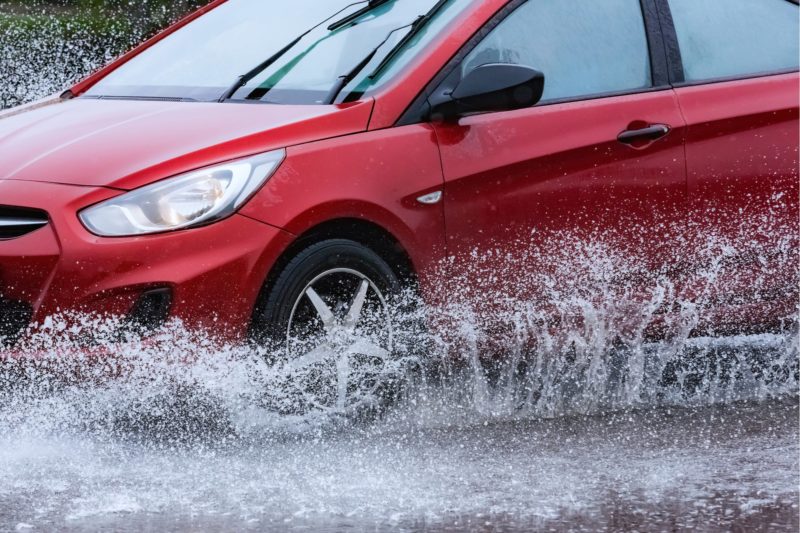Tips for Driving Safely in the Rain

We need the rain. Our grass, trees, and crops could not survive without rainfall. As necessary and beautiful as it is, rainfall can present dangerous conditions for drivers. Driving on a rainy day is more dangerous than driving in snow. According to data from the National Highway Traffic Safety Administration (NHTSA), when the pavement is wet, your likelihood of a crash is higher than it is during winter conditions such as snow and ice. Learn how to drive safely in the rain with these essential tips.
Check Your Tires
Proper tire tread depth and inflation are crucial to maintaining good traction on wet roadways. You can check the tread depth of your tires with a quarter inserted upside down into the tire groove. If you can see above Washington’s head, you may need new tires. Check each tire’s pressure, including the spare, at least once a month. The NHSTA offers more tire safety tips for additional information.
Turn On Your Headlights
When it’s raining, be sure to turn those headlights on. Even in the daytime. Turning your headlights on helps improve your visibility and allows other drivers to see you. However, some states have made it illegal to drive with your lights on while it’s raining, so be sure to check your state laws.
Avoid Sudden Stops
Braking suddenly and swerving, are dangerous when the roads are wet. Because your traction is reduced, it’s harder to avoid crashing into other cars or objects.
Slow Down
The National Safety Council (NSC) recommends a 3-second distance rule during dry weather. But when visibility is low, you should increase your distance to a minimum of 6 seconds.
Source: https://www.smartmotorist.com/
Determining the three-second distance rule is relatively easy:
- While behind a vehicle, select a sign, a tree, or a building.
- Note when the vehicle in front of you crosses that object.
- Now see how long it takes you to pass the same object (count 1-1,000; 2-1,000; 3-1,000).
- If it is less than three seconds, you need to slow down and increase your distance
Watch For Pedestrians
On rainy days, pedestrians might be prioritizing getting inside the building or their cars and may not pay attention to traffic. A lot of accidents involve pedestrians, and as the driver, it is your job to be aware of all of your surroundings.
Avoid Driving if You Can
If you can work from home, or cancel appointments, you should. The best way to stay safe is to stay off the roads.
What to Do When you Hydroplane
Hydroplaning happens when a vehicle’s tires lose contact with the road while riding on a layer of water.
- Don’t panic
- Don’t brake or accelerate suddenly
- Slowly ease your foot off the gas
- Gently turn your steering wheel in the direction of the hydroplane
- Wait to feel the tires return to the surface of the road
- After recovering from the hydroplane, you may need to pull over to take a few minutes to calm down. Hydroplaning can be very scary.
How Do I Avoid Hydroplaning?
Follow these important tips to avoid hydroplaning:
- Keep your tires properly inflated
- Rotate and replace tires when needed
- Slow down when roads are wet
- Stay away from puddles
- Avoid driving in outer lanes, as this is where water tends to gather
- Try to drive in the tire tracks created by the cars in front of you
- Try not to make sharp or quick turns
- Don’t use cruise control
- Drive in a lower gear
- Avoid hard braking
Drive With Extreme Caution
According to the U.S. Department of Transportation, on average, there are more than 950,000 automobile accidents each year because of wet pavement. When it is raining, you have to be patient and alert. Drive slowly. Follow these rainy weather driving tips to make sure you are safe while driving in the rain. Another way to make sure you stay safe on the roads is to have quality car insurance that gives you peace of mind. Bluefire Insurance can help you find high-quality auto insurance. Speak to your local Bluefire agent for more information.
Related Articles
-
 August 7th 2023
August 7th 2023The Top 10 Biggest Issues Auto Insurance Agents are Facing Today
In the post-pandemic world, insurance agents face numerous new challenges, as well as some old ones. In[...]
-
 June 17th 2024
June 17th 2024The Evolution of Personal Lines Insurance: What Independent Agents Need to Know
Ever since the development of the internet, personal lines insurance agencies have undergone a tremendous amount of[...]
-
 June 3rd 2024
June 3rd 2024Tapping into Emerging Markets: The Role of Independent Agents in Today’s Insurance Industry Trends
Insurance industry trends have shifted dramatically in the past two decades. The average client has a level[...]
-
 May 21st 2024
May 21st 2024What Does It Take to Be an Insurance Agent Today in America’s Southeast
Becoming an insurance producer can be an exciting and rewarding career path. In this job, you can[...]
